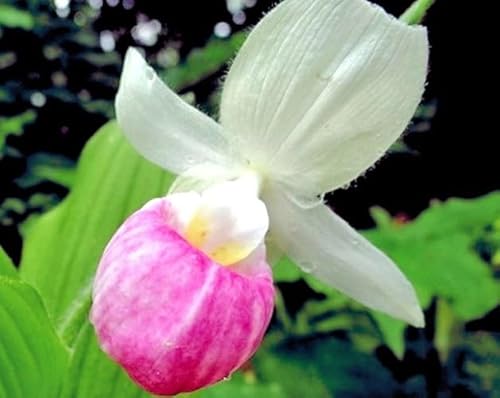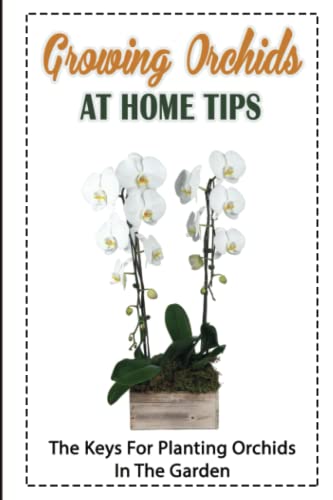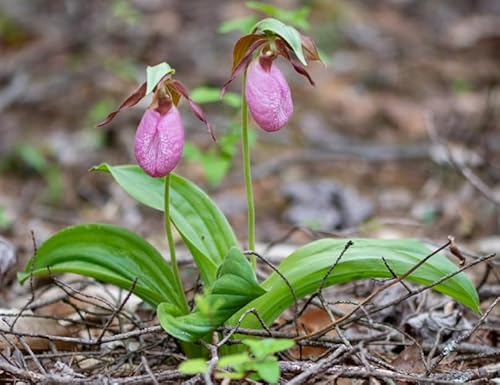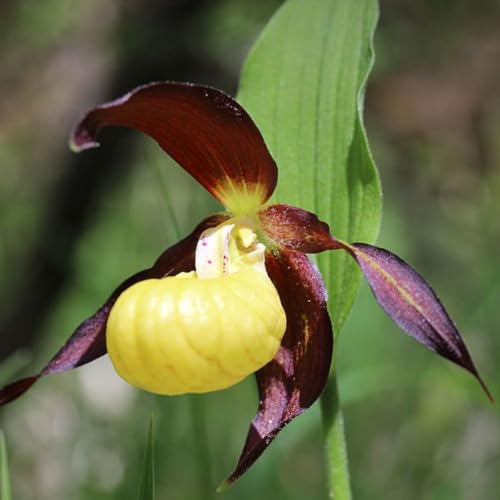That, they sell it here, calcium for chickens, I am going to apply a lot, at least 10% of the total mixtureEn nuestra localidad, las tiendas de alimentos venden tanto "grill de pollo" como el material que se muestra en la imagen a continuación. El grit de pollo es un medio más grueso pero también proporciona una fuente de calcio...
Yo uso el material que se muestra en la imagen libremente como "caparazón de ostra". Muchos cultivadores y criadores que conozco hacen lo mismo y lo llaman "caparazón de ostra"...
View attachment 48742
You are using an out of date browser. It may not display this or other websites correctly.
You should upgrade or use an alternative browser.
You should upgrade or use an alternative browser.
Difficulties in growing Kovachii (Stagnant growth)

Help Support Slippertalk Orchid Forum:
This site may earn a commission from merchant affiliate
links, including eBay, Amazon, and others.
Forgive me if I confused you, but the first photo, with the two buds, was the before.The plant doesn't look bad. It has a new shoot and it looks fine (so far). The roots are old and a bit muddy but they are still doing - albeit with greatly reduced efficiency. The new shoot look as if it will soon be able to form own roots.
Now it is like the other photos, with a bud and only two leaves D:
I don't have Sphagnum moos D:. (If I know, it's going to bring me misfortune XD)
Can I use stones and water in the base to replace the sphagnum?
Can I use stones and water in the base of the glass jar to replace the sphagnum?
Can I use stones and water in the base to replace the sphagnum?
I don't have Sphagnum moos D:. (I am aware that misfortune is slowly taking me XD)The plant doesn't look bad. It has a new shoot and it looks fine (so far). The roots are old and a bit muddy but they are still doing - albeit with greatly reduced efficiency. The new shoot look as if it will soon be able to form own roots.
Try the following:
Take a glass vase or similar container into which the plant including the pot fits completely. Line the bottom with living sphagnum moss and make it wet (really WET). This ensures a germ-free environment and regulates the necessary humidity. Dead sphagnum is useless. Reduce the opening of the container at the top with a lid or plastic film. This should leave about 1/4 to 1/3 of the opening open which helps with air circulation (through convection). This has been sufficient in my setups for years for at least for Paphiopedilum. Do not install a fan as this could collect (fungal) spores in the container and on the substrate and could cause more problems.
The temperature in the container should not be higher than 25°C. Humidity varies gradually with >90% at the bottom and less at the top because the opening is partially open. You can use a variety of substrates: rock wool, coconut husk chips or even bark, as you are currently using. The plant will then be permanently wet. But that's no problem in this setup, I've been doing it this way for years.
See example photos below for the setup.
Can I use stones and water in the base of the glass jar to replace the sphagnum?
When people recommend oyster shells they usually are referring to the chicken calcium. In the USA it is made of fossilized oyster shells. That should solve your pH and calcium problem with kovachii.That, they sell it here, calcium for chickens, I am going to apply a lot, at least 10% of the total mixture
You can also add carbon para la cocina to the substrate.
katzenhai2
Well-Known Member
Well, it still looks good (but not in your eyes). There's a new shoot and the leaves from the old one serve as nutrition.I don't have Sphagnum moos D:. (If I know, it's going to bring me misfortune XD)
Can I use stones and water in the base to replace the sphagnum?
I don't think that it will work without living Sphagnum moss. The risk of mold spreading is real. Don't use only water and stones.
Just replant it into new substrate containing calcium, keep it as cool and humid as possible and never let it dry out. Hope for the best.

$49.99 ($25.00 / Count)
2 Lady Slipper Orchids, Yellow Orchids Plants Live Lady Slipper, 2 Medium Root Bulbs Ornament Orchids Plant Root, No Leaf
KIM MARIE SMITH

$29.99 ($15.00 / Count)
2 Pink Lady Slipper Orchid Plant Live Bud Roots, Live Orchid Plants Bud for Planting, Rare Orchids Plant
RACHEAL LEE BARRETT

$31.33 ($3.13 / Fl Oz)
Vitabath Orchid Intrigue Everyday Skincare Set Moisturizing Shower Gel Wash, Reviving Lotion & Exfoliating Body Scrubber Pouf - Alluring Foam Cleanser & Dry Skin Hydration for Women & Men
Class01 USA (we record serial numbers)

$50.00 ($5.88 / Fl Oz)
Magnolia Orchid Collagen Age Signature Jelly Mask for All Skin Types, 8.5 Fl Oz/250 ml
BBCV

$26.79
$44.00
Understanding Orchids: An Uncomplicated Guide to Growing the World's Most Exotic Plants
SummitPark Prints

$16.50 ($1.65 / Count)
JMsolution Active Orchid Moisture-Korean facial Skin Care Mask- Hydrating-Orchid extract-Hydrating Moisture -10 sheets for dry skin
MABLEST LLC

$9.95 ($14.63 / Fl Oz)
Eternal Essence Oils 2 Pack 10ml Premium Fragrance Oil - Enchanted Orchid & Water Lily - for Candle, Soap Making, Aromatherapy, Diffusers, Home Care, & Humidifiers
eternal essence oils

$24.98 ($24.98 / Fl Oz)
SeoulCeuticals Chebula Active Serum for Face - Korean Skin Care Anti Aging Natural K Beauty Skincare With Hyaluronic Acid + Spotted Orchid for Healthy, Youthful Glowing Skin 1oz
Digital Beauty Group

$30.49 ($30.49 / Count)
$32.99 ($32.99 / Count)
Body & Skin Care Set, Spa Kit, Self-care Relaxation Gifts, Skin Care Collection with Essential Oils, Spa Gift Basket, Orchid Jasmine Bath and Body Gift Set Pampering, Birthday Home Spa Gifts
hailida

$29.00 ($14.50 / Fl Oz)
CoQ10 & Stem Cell Rejuvenation Cream - Fight Oxidative Stress, Reduce Wrinkles, Promote Youthful Skin. Goji Berry & Orchid Extracts. 2 oz.
Advanced Skincare Shop

$10.22
$10.99
Orchid Basics: Hints, tips & techniques to growing orchids with confidence
Amazon.com

$58.99 ($5.90 / Count)
10 Small Lady Slipper Orchids, Pink Orchids Plants Live Lady Slipper, Ornament Orchids Plant Root, No Leaf
KIM MARIE SMITH

$39.65 ($39.65 / Count)
$46.12 ($46.12 / Count)
hypehouse Allen + roth 8 in. Orchid Pot with Saucer White
Low Price Home Goods

$29.99 ($6.00 / Count)
5 Small Lady Slipper Orchids, Pink Orchids Plants Live Lady Slipper, Ornament Orchids Plant Root, No Leaf
KIM MARIE SMITH

$11.99 ($0.12 / Count)
CHUXAY GARDEN Cypripedioideae-Lady's Slipper Orchids,Lady Slipper Orchids 100 Seeds Tropical Exotic Orchids Rare Small Orchid
color green
- Joined
- Jun 6, 2006
- Messages
- 10,879
- Reaction score
- 340
Yeah, I don’t use it all the time. But I do use it after repotting, and when I have plants without great roots. My roots are way better this time around in general. I haven’t landed on a consistent fertilizer routine yet. Experimenting…I think it's a good idea to use kelp sparingly. Alfredo Manrique recommend adding powdered kelp to the fertilizer solution. He uses a Peruvian product., (no Kelpak available in Peru.)
I'm trying Kelpak now, but not long enough to say if it benefits or not.
Also, my neos seem to be generating better roots this year as well and I think it’s the Kelpak…but I’m about ready to back off as they slow down.
That tells me the particular dolomite he used was inappropriate, not that all dolomite is.Recently I had a conversation with Alfredo Manrique about kovachii potting media. He advised against Dolomite. I'll share part of the conversation.....
[2/9, 12:38 PM] Alfredo Manrique: You are right.
Calcium levels and high pH of the media are key factors.
Do not like dolomite.
[2/9, 2:57 PM] Lance Peck: What is ideal pH for the media?
[2/9, 2:57 PM] Lance Peck: What happens with dolomite?
[2/9, 3:26 PM] Alfredo Manrique: pH around 7.
Dolomite releases calcium too quick..
[2/9, 3:31 PM] Lance Peck: Does the excess release cause toxicity?
[2/9, 3:56 PM] Alfredo Manrique: It harms the roots.
Specific minerology, source, and particle size can all affect the dissolution rate.
All biostimulants should be used sparingly, as overexciting the natural processes of a plant can have negative side effects.I think it's a good idea to use kelp sparingly. Alfredo Manrique recommend adding powdered kelp to the fertilizer solution. He uses a Peruvian product., (no Kelpak available in Peru.)
I'm trying Kelpak now, but not long enough to say if it benefits or not.
I have seen flower deformities when overapplying synthetic auxins, and we must not forget that the very potent herbicide 2, 4-D is a biostimulant that works so effectively that it burns plants out.
As an experiment, I have dosed Kelpak at 1:128 (one ounce per gallon) twice a week and saw no such negatives. However, I recommend half that dose, applied no more than every two weeks, as recommended by the manufacturer.
Dried, powdered kelp products a have had the majority of their bioactive phytochemicals destroyed in processing, and are likely not much more than additional fertilizer, so adding those to a controlled feeding regimen is disruptive, more than stimulating.
Use the Kelpak according to the label directions, and I guarantee you’ll see results. I got an order today from a guy who said Chuck Acker told him to get it.
It is ground calcined oyster shell, not fossilized.When people recommend oyster shells they usually are referring to the chicken calcium. In the USA it is made of fossilized oyster shells. That should solve your pH and calcium problem with kovachii.
You can also add carbon para la cocina to the substrate.
Fossilized or calcined? Probably does not matter to the plantIt is ground calcined oyster shell, not fossilized.
Years back I contacted a producer of oyster shell feed to inquire if the feed might be high in sodium because the shells come from the ocean. He told me they are mining inland fossil oyster beds rather the marine estuary shell mounds.
And how to know if a sack of dolomite is appropriate?That tells me the particular dolomite he used was inappropriate, not that all dolomite is.
Too complicated.
Alfredo's advice is based on his experience growing quantities of kovachii plants... that is don't risk using dolomite on kovachii plants".
Interesting. Why would a deposit of fossilized oyster shell have less sodium? If it's incorporated into the crystal structure, it's not coming out with age. If it's not in the crystal structure, then firing it should eliminate it anyway.Fossilized or calcined? Probably does not matter to the plant
Years back I contacted a producer of oyster shell feed to inquire if the feed might be high in sodium because the shells come from the ocean. He told me they are mining inland fossil oyster beds rather the marine estuary shell mounds.
If you are in a market that gives you options and you learn what is important, you can choose.And how to know if a sack of dolomite is appropriate?
Too complicated.
Alfredo's advice is based on his experience growing quantities of kovachii plants... that is don't risk using dolomite on kovachii plants".
I used to use dolomite as a substrate in African cichlid tanks. Some was stable as heel, others were chalky and friable.
I assumed by freshwater leaching of surface sodium as the shell beds slowly over time became terrestrial.Interesting. Why would a deposit of fossilized oyster shell have less sodium?
As you can see, no roots were born. So, I wrapped up some calcium
in an envelope, so that it constantly supplies calcium (I think), I also plan to add lime in the same way (as the substrate is loose, I do it like tea bags)
in an envelope, so that it constantly supplies calcium (I think), I also plan to add lime in the same way (as the substrate is loose, I do it like tea bags)
I also had the terrible surprise that the old substrate had a PH of 5!
Check the tap water and the irrigation tank and they all have a PH of 5!
It surprises me because 1 year ago I did PH tests (practicing with homemade culture media XD) and I remember very well that the PH was 6.5-7
Check the tap water and the irrigation tank and they all have a PH of 5!
It surprises me because 1 year ago I did PH tests (practicing with homemade culture media XD) and I remember very well that the PH was 6.5-7
The best way to correct the substrate pH is to not use highly acidic components. You should test the pH of your bark. It may be very acidic and the main cause of your root problems. Soak some fresh bark in water and then test the waters pH.What homemade product can I use to raise the pH to 7 or so?
If your bark is too acidic don't use it for kovachii.
Similar threads
- Replies
- 5
- Views
- 1K
- Replies
- 3
- Views
- 2K
- Replies
- 6
- Views
- 490































